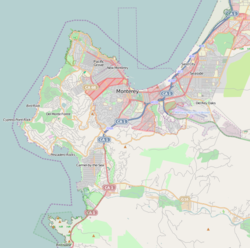History
The YWCA Pacific Coast conferences were originally held at the Capitola, California hotel until 1911. Following growth in attendance and a desire to establish a permanent location, Phoebe Hearst hosted the 1912 conference at her hacienda in Pleasanton, California. Proceeds from that event were used to secure land for a permanent site. A committee persuaded the Pacific Improvement Company to donate 30 acres (120,000 m2) to the YWCA in 1912. In early 1913, it was announced that Julia Morgan, then engaged with the Oakland YWCA building, would also design the new Asilomar campgrounds in the Arts & Crafts style. Construction began in the spring of 1913, and by August, the Social Hall and Longhouses were completed, hosting 300 girls for the inaugural summer program. Merrill Hall, Morgan’s final design for Asilomar, was dedicated in 1928.
Several other prominent California women including Ellen Browning Scripps, Mrs. Warren Olney Jr. and Mary Sroufe Merrill were involved in the creation of the retreat. [7]
In 1956, the State of California acquired Asilomar and commissioned architect John Carl Warnecke to design seven additional buildings to expand the grounds. [8] Asilomar was declared a National Historic Landmark in 1987 for its role in women's recreation, the development of the YWCA, and the resort heritage of nearby Monterey, California. [9] [10] [11]
Present Day
Today, the property is officially known as Asilomar State Beach and Conference Grounds and is operated by California State Parks. While it primarily functions as a conference center, it also welcomes individual guests and is frequently used for social events such as family reunions. The grounds remain open to the public. Between 1956 and 1994, the site was managed by various nonprofit organizations in collaboration with California State Parks. Delaware North Companies operated the facility from 1997 to 2007, after which Aramark took over operations in 2009 under a 20-year contract. [12]
To maintain its rustic charm, the rooms at Asilomar are free of telephones and televisions, although Wi-Fi has been added.
In 2012, construction began to improve the site's accessibility in compliance with the Americans with Disabilities Act. These renovations, which continued through 2014, included replacing old asphalt pathways with brick pavers and improving accessibility to several buildings.
This page is based on this
Wikipedia article Text is available under the
CC BY-SA 4.0 license; additional terms may apply.
Images, videos and audio are available under their respective licenses.










